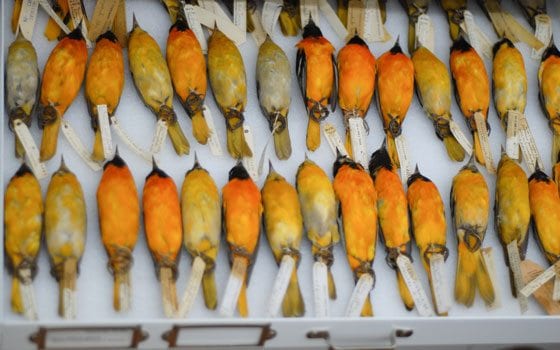

Author: Daniela CarideBirds from the collection of Harvard’s Museum of Comparative Zoology are pictured. The museum’s collection, started in 1859 by Louis Agassiz, today includes more than 350,000 samples, making it the largest university collection in the world. These specimens are a major source in professor Scott Edwards’ study of the evolution of birds.

CAMBRIDGE — Scott Edwards thinks he was maybe 10 years old when a neighbor took him bird watching for the first time.
“It was about fifth or sixth grade, because I remember how ‘uncool’ it was to be a bird watcher,” Edwards says, laughing. “I didn’t tell any of my friends.”
But the fear of what his friends might say didn’t keep Edwards from going back under the trees and waiting for the next bird to appear. To him, bird watching became “a reason to get outside, get exercise and learn about the environment.”
It also led him to his life’s work.
Now 45, Edwards watches birds as part of his job at Harvard University. He is a professor of organismic and evolutionary biology, curator of ornithology and an Alexander Agassiz Professor of Zoology in Harvard’s Museum of Comparative Zoology (MCZ).
And it all started in the urban parks of the Riverdale section of the Bronx, N.Y.
“I sort of never looked back,” says Edwards during an interview in his office at Harvard. The room is spacious enough to accommodate the towers of paper piled high on desks as well as the stacks of books and framed pictures of nature scenes — and, of course, birds — that line the walls.
As a scientist who studies the evolution of birds, looking back is an important aspect of Edwards’ job. He and his team measure, analyze and run complex DNA studies on birds, trying to locate and verify slight genetic mutations that could influence their future as a species.
To identify those mutations, Edwards compares birds of different species and of the same species to one another. He compares subjects found in nature, as well as those from the MCZ’s bird collection. Started in 1859 by Louis Agassiz, Alexander’s father, today the collection includes more than 350,000 birds, making it the largest university collection in the world.
“We can get a lot of information now, with [new] technology, from these old specimens,” says Edwards. “We can even tell things like what they were eating [at] the time, just through chemical analysis. We can look at their DNA.”
Implementing those new techniques can lead to the kind of exciting breakthroughs that one might not associate with a science museum.
“A lot of times, people think of museums as very dusty, old places,” says Edwards. “But especially [at] universities like [Harvard], there’s cutting edge approaches being applied.”
Edwards says that comparing different species is one of the most powerful tools researchers have to understand how animals have changed over time. Through this kind of work, for example, scientists have been able to understand a bit more about how dinosaurs evolved into birds.
The comparison technique also helps researchers identify the different traits that arise in birds from specific areas and what changes occur in different species.
Mutations take place due to a spontaneous change in the DNA, according to Edwards. Their occurrence is essentially random — when DNA is copied from generation to generation, he says, “sometimes mistakes are made.”






